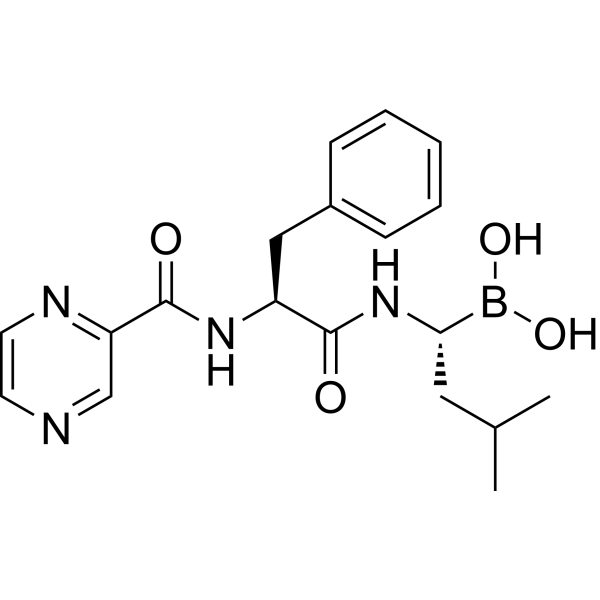Home
Products
Bortezomib (PS-341)



| Product Name | Bortezomib (PS-341) |
| Price: | Inquiry |
| Catalog No.: | CN00546 |
| CAS No.: | 179324-69-7 |
| Molecular Formula: | C19H25BN4O4 |
| Molecular Weight: | 384.2 g/mol |
| Purity: | >=98% |
| Type of Compound: | Alkaloids |
| Physical Desc.: | Powder |
| Source: | |
| Solvent: | Chloroform, Dichloromethane, Ethyl Acetate, DMSO, Acetone, etc. |
| SMILES: | CC(C[C@@H](B(O)O)NC(=O)[C@@H](NC(=O)c1cnccn1)Cc1ccccc1)C |
| Contact us | |
|---|---|
| First Name: | |
| Last Name: | |
| E-mail: | |
| Question: | |
| Description | Bortezomib (PS-341) is a potent 20S proteasome inhibitor with a Ki of 0.6 nM. |
| Target | Ki: 0.6 nM (20S proteasome)[1] |
| In Vitro | Bortezomib (PS-341) effects proteins that control cell cycle progression. Treatment of PC-3 cells with Bortezomib (100 nM) for 8 h results in the accumulation of cells in G2-M, with a corresponding decrease in the number of cells in G1. The Bortezomib doses at which 50% of PC-3 cells are killed at 24 and 48 h are determined to be 100 and 20 nM, respectively[1]. Bortezomib is a highly selective, reversible inhibitor of the 26S proteasome. Inhibition of the proteasome by Bortezomib results in activation of JNK, stabilization of p53, Bid, Bax, p21, p27, caveolin-1, and IκBα, resulting in inhibition of NF-κB[2]. The IC50 of Bortezomib is found to be 2.46 nM for 26S proteasome in the B16F10 cells[3]. |
| In Vivo | Mice bearing PC-3 tumors are treated with Bortezomib (i.v., 0.3 or 1.0 mg/kg). Bortezomib (1.0 mg/kg) results in a significant decrease in tumor growth ~60%. Bortezomib (0.3 mg/kg) produces a 16% decrease in tumor volume but did not reach significance[1]. Bortezomib (0.2 mg/kg) significantly decreases the withdrawal threshold on days 11 and 15 and increases the number of withdrawal responses on days 11 and 15 compared with the vehicle group in the von Frey and acetone tests[4]. |
| Cell Assay | The human PC-3 prostate tumor cells are treated with Bortezomib (0.1 nM, 1 nM, 10 nM, 100 nM, 1 μM, 10 μM) for 24-48 h in complete medium. Cytotoxicity is measured using a MTT assay[1]. |
| Animal Admin | Mice[1] Male nude mice (18-20 g; n=51) are used. Bortezomib (0.3 or 1.0 mg/kg) is administered in vehicle i.v. using a dose volume of 100 μL per mouse or directly into the tumor in a 10 μL volume. Due to the comparatively high levels of Bortezomib in the prostate, after i.v. dosing of radiolabeled drug, it is decided to examine the effects of this novel compound in the prostate, PC-3, xenograft tumor model. Animals are treated when the tumors become palpable (>300 mm3). Male nude mice (18-20 g; n=51) are used. Bortezomib (0.3 or 1.0 mg/kg) is administered in vehicle i.v. using a dose volume of 100 μL per mouse or directly into the tumor in a 10 μL volume. Due to the comparatively high levels of Bortezomib in the prostate, after i.v. dosing of radiolabeled drug, it is decided to examine the effects of this novel compound in the prostate, PC-3, xenograft tumor model. Animals are treated when the tumors become palpable (>300 mm3). Rats[4] Male Sprague-Dawley rats weighing 200-250 g are used. Bortezomib (0.05, 0.1, or 0.2 mg/kg) or vehicle (5% DMSO solution) is administered intraperitoneally (i.p.) twice a week for 2 weeks (on days 1, 4, 8, and 11). The administration schedule and doses of Bortezomib are determined based on clinical treatment (1.3 mg/m2 of Bortezomib on days 1, 4, 8, and 11). |
| Density | 1.2±0.1 g/cm3 |
| Exact Mass | 384.196899 |
| PSA | 124.44000 |
| LogP | 2.45 |
| Storage condition | Hygroscopic, -20°C Freezer, Under Inert Atmosphere |